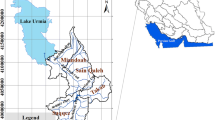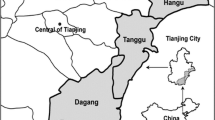Abstract
Intuitionistic Fuzzy Optimization (IFO) approach is one of the scientific approaches to the planning of multi–purpose water resource systems. The water resources reservoirs invariably need to meet the objectives, namely, maximization of net irrigation benefits (NIB), maximization of employment (EG), minimization of cultivation cost (CC), and maximization of revenue generation on account of industrial and municipal supplies (MI). In the current study, Intuitionistic Fuzzy Optimization Multi–objective fuzzy linear programming (IFO MOFLP) model and its variants are developed for solving the aforesaid four conflicting objectives with relevant constraints of the system. The performance of the recommended IFO MOFLP model is compared with the MOFLP model (Average operator Case–I) developed by Mirajkar and Patel (J Water Resour Plan Manag 142(11):1–16, 2016) with reference to uncertainty parameters like degree of acceptance (α), rejection (β), and hesitation index (π) and values of objective functions. The sensitivity of the uncertainty parameters is also quantified with reference to the scaling factor of the IFO MOFLP approach. The significance of the proposed model has been highlighted by comparing the simulated cropping pattern and objective functions of the model with the actual cropping pattern used in the command area for the same inflow condition in the reservoir. The suggested model with new parameters like α, β, and π, would assist decision– makers in applying the same to real–world problems with greater certainty.





Similar content being viewed by others
Data Availability
The corresponding author has access to all the data, models, or algorithms used in current investigation. The data used can be released to the public platform only after getting permissions from the relevant data providing agencies.
References
Angelov PP (1997) Optimization in an Intuitionistic fuzzy environment. Fuzzy Sets Syst 86(3):299–306. https://doi.org/10.1016/S0165-0114(96)00009-7
Arunkumar R, Jothiprakash V (2016) A Multi–objective fuzzy linear programming model for sustainable integrated operation of a multireservoir system. Lakes Reserv Res Manag 21(3):171–187. https://doi.org/10.1111/lre.12136
Atanassov KT (1986) Intuitionistic fuzzy sets. Fuzzy Sets Syst 20(1):87–96. https://doi.org/10.1016/S0165-0114(86)80034-3
Bharati SK, Singh SR (2014) Solving multi objective linear programming problems using intuitionistic fuzzy optimization method: a comparative study. Int J Model Optim 4(1):10–16. https://doi.org/10.7763/ijmo.2014.v4.339
Chow CW, Cooper JC, Waller WS (1988) Participative budgeting: Effects of a truth-inducing pay schemeand information asymmetry on slack and performance. Account Rev 63(1):111–122
Garai AG, Roy TK (2013) Intuitionistic fuzzy optimization: usage of hesitation index. Int J Comput Technol 19(4):60–68. https://doi.org/10.24297/ijct.v10i4.3248
Hernandez EA, Uddameri V (2010) Selecting agricultural best management practices for water conservation and quality improvements using Atanassov’s intuitionistic fuzzy sets. Water Resour Manag 24(15):4589–4612. https://doi.org/10.1007/s11269-010-9681-1. (Springer)
Li M, Fu Q, Singh VP, Ma M, Liu X (2017) An intuitionistic fuzzy multi–objective non–linear programming model for sustainable irrigation water allocation under the combination of dry and wet conditions. J Hydrol 555:80–94. https://doi.org/10.1016/j.jhydrol.2017.09.055
Mirajkar AB, Patel PL (2016) Multi–objective two-phase fuzzy optimization approaches in management of water resources. J Water Resour Plan Manag 142(11):1–16. https://doi.org/10.1061/(ASCE)WR.1943-5452.0000682
Mohan S, Jothiprakash V (2003) Development of priority-based policies for conjunctive use of surface and groundwater. Water Int 28(2):254–267
Morankar DV, Srinivasa Raju K, Nagesh Kumar D (2013) Integrated sustainable irrigation planning with multi–objective fuzzy optimization approach. Water Resour Manag 27(11):3981–4004. https://doi.org/10.1007/s11269-013-0391-3. (Springer)
Pawar SV, Patel PL, Mirajkar AB (2022a) Intuitionistic fuzzy approach in multi–objective optimization for KRBMC irrigation system, India. ISH J Hydraul Eng 28(1):463–470. https://doi.org/10.1080/09715010.2020.1781700
Pawar SV, Patel PL, Mirajkar AB (2022b) Intuitionistic fuzzy optimization approach in optimal irrigation planning of Ukai–Kakrapar irrigation project, India. ISH J Hydraul Eng. https://doi.org/10.1080/09715010.2022.2052988. (Published Online)
Pawar SV, Patel PL, Mirajkar AB (2023) Multiobjective intuitionistic fuzzy optimization approach in optimal irrigation planning and operation of reservoir. Water Resour Manag. https://doi.org/10.1007/s11269-022-03406-8. (Springer)
Raju KS, Vasan A, Gupta P, Ganesan K, Mathur H (2012) Multi–objective differential evolution application to irrigation planning. ISH J Hydraul Eng 18(1):54–64. https://doi.org/10.1080/09715010.2012.662428
Ren C, Guo P, Tan Q, Zhang L (2017) A multi–objective fuzzy programming model for optimal use of irrigation water and land resources under uncertainty in Gansu Province, China. J Clean Prod 164:85–94. https://doi.org/10.1016/j.jclepro.2017.06.185
Acknowledgements
The Centre of Excellence (CoE) on Water Resources and Flood Management, established under the TEQIP II grant of the Ministry of Human Resource Development, Government of India, is gratefully acknowledged by the authors for providing the necessary computational facility in analyzing the data of current investigation. The Sinchan Bhavan, Pune, Khadakwasla Irrigation Division, Pune, Maharashtra, India, are also thankfully acknowledged by the authors for supplying the data required for analysis in the current work.
Funding
The authors declare that no funds, grants, or other support were received during the preparation of this manuscript.
Author information
Authors and Affiliations
Contributions
Conceptualization– Sangita V. Pawar, Prem Lal Patel, Ashwini B. Mirajkar; Data curation– Ashwini B. Mirajkar, Prem Lal Patel; Formal analysis– Sangita V. Pawar and Ashwini B. Mirajkar; Project administration– Sangita V. Pawar, Prem Lal Patel, Ashwini B. Mirajkar; Software– Sangita V. Pawar and Ashwini B. Mirajkar; Supervision and Validation– Sangita V. Pawar, Prem Lal. Patel, Ashwini B. Mirajkar; Writing–original draft– Sangita V. Pawar, Writing–review and editing– Sangita V. Pawar, Prem Lal Patel, Ashwini B. Mirajkar.
Corresponding author
Ethics declarations
Ethical Approval
N.A.
Consent to Participate
All authors have consented to participate in the publication process.
Consent to Publish
All authors agree to publish this manuscript.
Competing Interests
The authors have no relevant financial or non–financial interests for disclosure.
Additional information
Publisher's Note
Springer Nature remains neutral with regard to jurisdictional claims in published maps and institutional affiliations.
Supplementary Information
Below is the link to the electronic supplementary material.
Rights and permissions
Springer Nature or its licensor (e.g. a society or other partner) holds exclusive rights to this article under a publishing agreement with the author(s) or other rightsholder(s); author self-archiving of the accepted manuscript version of this article is solely governed by the terms of such publishing agreement and applicable law.
About this article
Cite this article
Pawar, S., Patel, P. & Mirajkar, A.B. Relevance of Intuitionistic Fuzzy Optimization Approach in Planning of a Multi–Objective Water Resource System. Water Resour Manage 38, 2935–2959 (2024). https://doi.org/10.1007/s11269-024-03799-8
Received:
Accepted:
Published:
Issue Date:
DOI: https://doi.org/10.1007/s11269-024-03799-8




